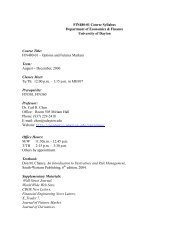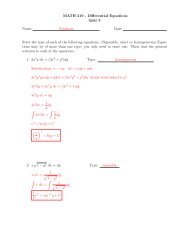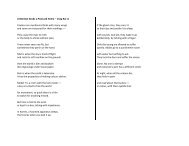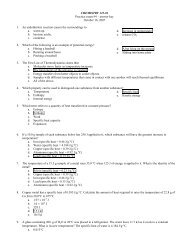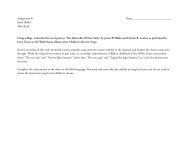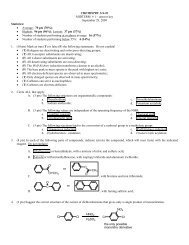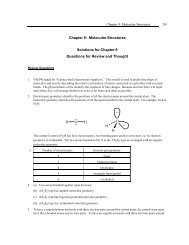Chap 26
Chap 26
Chap 26
You also want an ePaper? Increase the reach of your titles
YUMPU automatically turns print PDFs into web optimized ePapers that Google loves.
MONEY, BANKS, AND THE FEDERAL RESERVE 233<br />
Answers to the Review Quizzes<br />
Page 236 (page 608 in Economics)<br />
1. Money is anything that is a means of payment. Money has three functions: medium of exchange<br />
(money is accepted in exchange for goods and services), unit of account (prices are quoted in terms<br />
of money), and store of value (money can be held and exchanged for goods and services later).<br />
Packets of chewing gum do not function as money because they are not particularly good as stores<br />
of value—gum deteriorates. Additionally, packets of gum are not generally accepted in exchange<br />
for goods and services, so packets of gum are not a medium of exchange.<br />
2. Commodities are not used as money because of several problems. Many commodities are bulky.<br />
And many commodities change in value over time. Using as money a commodity that changes in<br />
value would be awkward because prices would change simply because the commodity’s value<br />
changed. Additionally, using a commodity as money implies that money has a high opportunity<br />
cost, whereas currency and bank deposits have low opportunity costs.<br />
3. The main component of money in the United States today is deposits at banks and other<br />
depository institutions. Currency and travelers’ checks are two other components of money.<br />
4. The official measures of money are M1 (the sum of currency, travelers’ checks, and checking<br />
deposits owned by individuals and businesses), M2 (the sum of M1, savings deposits, time<br />
deposits, and money market mutual funds), and M3 (the sum of M2, large-scale time deposits,<br />
and term deposits). All the components of M1 are truly money because all the components serve<br />
as a means of payment. Some of the components of M2 and especially M3 are not truly money<br />
because they are not a means of payment. (For instance, funds at money market mutual funds<br />
cannot be used as a means of payment for small purchases.) But all of these “non-money” assets<br />
are highly liquid so they are operationally similar to money.<br />
5. Checks and credit cards are not money because they are not a means of payment. A check is an<br />
order to transfer a deposit from one person to another. The deposits are money but the checks are<br />
not. Credit cards are a way to obtain an instant loan. The loan still needs to be repaid with money<br />
so the credit card is not a means of payment, that is, it is not money.<br />
Page 241 (page 613 in Economics)<br />
1. All depository institutions take deposits from households and firms and make credit available to<br />
other households and firms. Savings and loan associations, savings banks, and credit unions differ<br />
from other depository institutions because they generally make consumer loans and home<br />
purchase loans. Money market mutual funds differ from other intermediaries because they use<br />
their deposits to buy liquid assets such as U.S. Treasury bills, that is, they provide credit but do<br />
not make loans as such.<br />
2. Liquidity is the ability to turn an asset quickly into money at a fixed price. Depository institutions<br />
create liquidity when they offer deposits that can be withdrawn as money at short (or no) notice<br />
and then use these deposits to make long-term loans.<br />
3. Depository institutions lower the cost of borrowing and lending because they specialize in<br />
borrowing and lending. For instance, a firm that wants to borrow a large sum of money need only<br />
visit a depository institution to arrange such a loan. In the absence of depository institutions, the<br />
firm would need to undertake many transactions with many loaners, which would be a costly<br />
endeavor. Similarly, a saver wishing to loan money simply deposits it with an institution which<br />
will loan it for the saver. In the absence of depository institutions, the saver would need to contact<br />
many potential borrowers, which would be a costly endeavor. Depository institutions lower the<br />
cost of monitoring borrowers because they specialize in this task. Such specialization, as well as the




